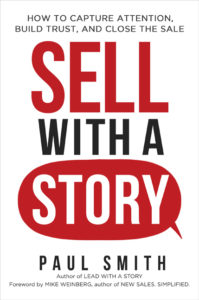Podcast: Play in new window | Download | Embed
Subscribe: RSS
Podcast (sell-with-a-story-series1): Play in new window | Download | Embed
Subscribe: RSS
Stories have always had a unique power to lead, influence, persuade, and sell. Here are my top 10 reasons you’ll want to add more of them to your repertoire instead of relying solely on a dry sales pitch.
1. STORIES HELP THE BUYER RELAX AND JUST LISTEN
It’s similar to the response college students have when the professor stops writing formulas on the board and starts sharing a personal anecdote or analogy. The students relax their shoulders for a minute, stop taking notes, lean back in their chairs, and just listen.
Storytelling works well precisely because it doesn’t sound like a sales pitch to a buyer, just like a story doesn’t sound like a lecture to a student. So in both cases, the buyer and the student open up their minds and just listen.
2. STORIES HELP BUILD STRONG RELATIONSHIPS
Storytelling almost magically builds trust, which is the foundation of good relationships. A 1999 New York Times/CBS survey asked, “Of people in general, how many do you think are trustworthy?” The average answer was 30 percent. Then it asked, “Of people you know, how many do you think are trustworthy?” The average answer shot up to 70 percent! What does that suggest? It suggests that people who don’t know you default to not trusting you. But people who do know you default to trusting you unless you’ve given them a reason not to.
Telling a story can move you from the 30 percent to the 70 percent, because it provides a personal, intimate, and perhaps vulnerable glimpse into your world. Reading the facts on your resume doesn’t really let someone get to know you, and spending enough time together could take months or years. A story is the shortest distance between being a stranger and a friend.
3. STORYTELLING SPEAKS TO THE PART OF THE BRAIN WHERE DECISIONS ARE ACTUALLY MADE
Much of the cognitive science in the past two decades tells us that human beings often make subconscious, emotional, and sometimes irrational decisions in one place in the brain, and then justify those decisions rationally and logically in another place. So if you’re trying to influence buyers’ decisions, using facts and rational arguments alone isn’t enough. You need to influence them emotionally, and stories are your best vehicle to do that.
4. STORIES MAKE IT EASIER FOR THE BUYER TO REMEMBER YOU, YOUR IDEAS, AND YOUR PRODUCT
Many studies show that facts are easier to remember if they’re embedded in a story than if they’re delivered in any other form. For example, Stanford University Professor Chip Heath asked his students to give one-minute speeches about crime. In his book, Made to Stick, he recounts that the average student used 2.5 statistics in his speech, while only one in ten students told a story. But when students were asked to recall the speeches, 63 percent remembered details of stories. Only 5 percent remembered any individual statistic.
Stories create a meaningful scene in your mind that a simple list of facts doesn’t. That scene is easier for your mind to remember than the list of facts. Stories create scenes. Facts don’t.
5. STORYTELLING ACTUALLY INCREASES THE VALUE OF THE PRODUCT YOU’RE SELLING
In July 2009, journalist Rob Walker and author Josh Glenn conducted a remarkable experiment. They purchased 100 ordinary used objects from thrift stores and garage sales—a jar of marbles, a meat thermometer, a wooden mallet, a toy pink horse, a bottle opener, a Santa Claus nutcracker, etc. Each item cost on average $1.29.
 They then asked volunteers to write short, fictional stories about each item. Walker and Glenn then placed each item for sale on eBay. But instead of putting a simple description next to the picture of each item, they put only the fictional story that had been written for it.
They then asked volunteers to write short, fictional stories about each item. Walker and Glenn then placed each item for sale on eBay. But instead of putting a simple description next to the picture of each item, they put only the fictional story that had been written for it.
Within five months, all 100 items had been sold. The experimenters originally paid a total of $128.74 for the items, but the resale price paid on eBay totaled $3,612.51, or a 2,800 percent increase in value. In the words of Walker and Glenn, their experiment showed that “Narrative transforms insignificant objects into significant ones.” In other words, stories turned cheap objects into valuable ones.
6. STORYTELLING HIGHLIGHTS YOUR MAIN IDEA BY MOVING IT TO ANOTHER CONTEXT
In a wonderful and underappreciated book, Soft Tales and Hard Asses, Paul Lanigan and Denis Goodbody describe this aspect of storytelling working like a photographer uses a cyclorama—that curved white background you see in a studio for the main attraction to stand in front of. “Everything they photograph in front of it is pin-sharp and clear. Every detail is visible because there are no distractions. In our case, we need the story backdrop to give a context in which the action can take place. By making it alien, surreal, or fantastic, we remind the listener that the part at the center is the bit they need to focus on.”
7. STORIES ARE CONTAGIOUS
Make a great sales pitch and it stays in the room where you made it. But when you tell a great story, it can travel around the world. In his book What’s Your Story?, sales guru Craig Wortmann observes: “Salespeople are rarely able to reach all of the decision makers at once. This is where stories are also useful, because they more readily spread from client to client.”
Wortmann explains by asking when was the last time you heard anyone say, “Wow! You’re never going to believe the PowerPoint presentation I just saw!” Probably never. But people say that about a good story all the time.
Even if you’ve been on the receiving end of a great sales pitch, it’s hard to repeat it to someone else in your office without having all the same materials and slides on hand that the salesperson had when she made the pitch to you. But anyone can easily repeat a story without prompting, notes, or even a single slide—and they do. And that’s the point.
8. STORYTELLING GIVES YOU AN OPPORTUNITY TO BE ORIGINAL
Let’s face it: most professional buyers have seen it all. They’ve heard every pitch, tactic, and attempted close line in the book. They’ve heard them from you, your competitors, and the last two people who had your job. And as storytelling expert Doug Stevenson observes in his book Story Theater Method, “People are yearning for someone to tell them something they don’t know already.” Your story lets you give that to them.
Storytelling gives you a way to stand out in the crowd with something interesting and original to say. It distinguishes you not only from your peers and competitors but also from your predecessors, because the stories you tell won’t be the ones cooked up by the marketing department, your ad agency, or even the sales manager. They’re your stories. Nobody else will have them unless you decide to share.
9. YOUR BUYERS WANT MORE STORIES FROM YOU
Forrester Research conducted a study in 2013 asking 319 executive-level buyers in North America and Europe how frequently the salespeople who call on them are prepared in certain ways. The buyers responded that 62 percent of the time the salespeople were knowledgeable about the company and products they represented; 42 percent of the time they were knowledgeable about the buyer’s industry; but only 21 percent of the time (the lowest in the survey) did they have relevant examples or case studies to share. In other words, only one in five sales calls include enough stories to satisfy the buyer.
My own qualitative research supports this. One of the questions I asked procurement professionals was “What kind of stories do you want to hear from salespeople?” Among the most consistent answers were stories to help them understand:
1. Why and how your company was founded,
2. Who you are and what your values are,
3. How and why the product you’re selling was invented,
4. Stories about how the product is made, and
5. The level of integrity they can expect from you and your company
10. STORYTELLING IS MORE FUN THAN DELIVERING A CANNED SALES PITCH, FOR YOU AND THE BUYER
Jennifer Doherty is the chief procurement officer for the Commonwealth of Pennsylvania. She says, “You can tell when a salesperson has delivered the same sales pitch over and over again and they’re bored with it. They quickly flip through a standard PowerPoint deck, without a lot of voice inflection or stopping to see if you have any questions.”
And if you think delivering a monotonous, canned sales pitch is boring, how exciting do you think it is to be on the receiving end of one? Telling stories gives you an excuse to go off script and keep the conversation organic and flowing—which, as Jennifer points out, is critical because buying and selling “is like dating. If it’s not organic and flowing, it’s probably not going to work out.”
I share this reason last because if I’d included it as one of the first reasons, some readers would surely take this entire effort less seriously. Why? Because “fun” doesn’t sound like a legitimate reason to make a change in how you go about making your living. But it should be. If you’re planning to spend three decades or more engaged in any activity, you’d damn well better enjoy it, or you won’t last half that long before you quit to take on something you do enjoy. And you’ll also be making it more enjoyable for the hundreds of potential buyers whose three decades of time will be spent in meetings with people like you. They’ll thank you with more business anyway.
Special Offer: As a thank you and reward for listening to or reading this new podcast series, I’m giving away three free copies of the Audible edition of the book it’s based on, Sell with a Story: How to Capture Attention, Build Trust, and Close the Sale. That’s the downloadable audio version that you would listen to on your phone or in the car. If you’d like to win one of those, click this link and play this podcast directly from iTunes. You can skip to the last 60 seconds of the podcast where you’ll find instructions for how to win one of the free Audible books. I’ll leave the contest open for 2 weeks after this podcast first posts. Good luck!
Source: Sell with a Story, by Paul Smith
—
 Paul Smith is one of the world’s leading experts on business storytelling. He’s a keynote speaker, storytelling coach, and bestselling author of the books Lead with a Story, Parenting with a Story, and Sell with a Story.
Paul Smith is one of the world’s leading experts on business storytelling. He’s a keynote speaker, storytelling coach, and bestselling author of the books Lead with a Story, Parenting with a Story, and Sell with a Story.


 Connect with him via email here.
Connect with him via email here.
Follow him on Facebook, LinkedIn, Twitter, and Instagram.
Sign up for his newsletter here to get one new story a week delivered to your inbox.


